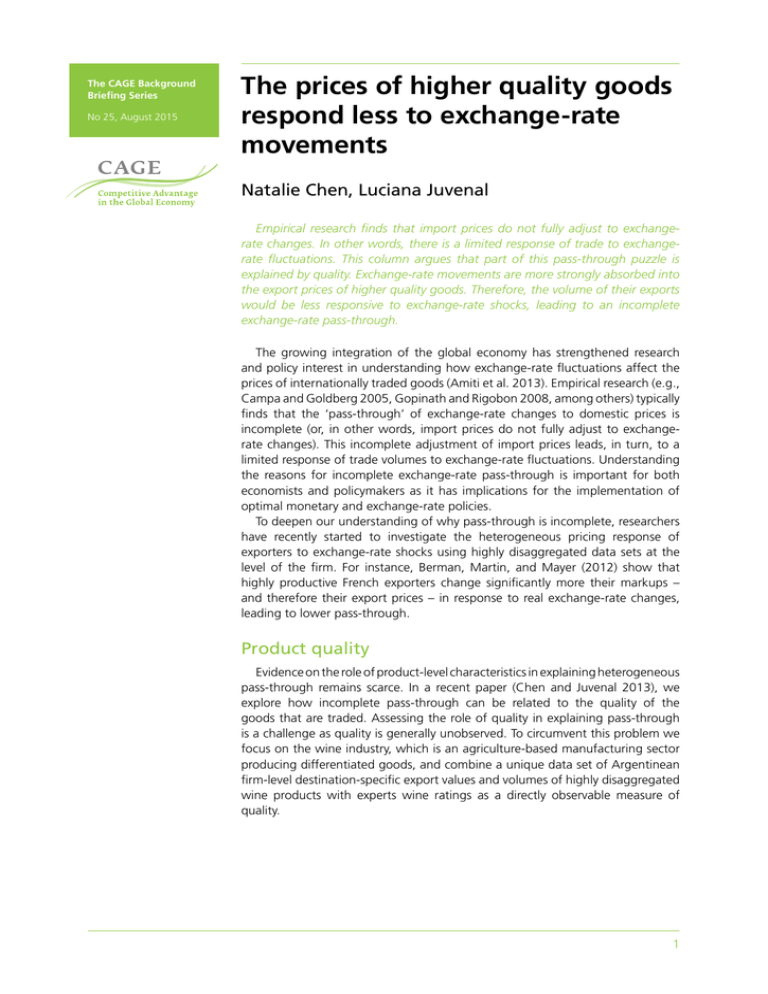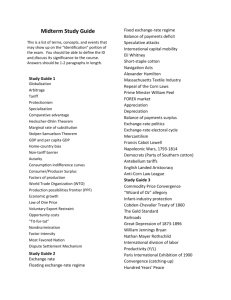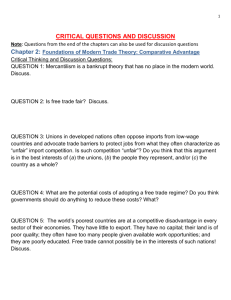The prices of higher quality goods respond less to exchange-rate movements
advertisement

The CAGE Background Briefing Series No 25, August 2015 The prices of higher quality goods respond less to exchange-rate movements Natalie Chen, Luciana Juvenal Empirical research finds that import prices do not fully adjust to exchangerate changes. In other words, there is a limited response of trade to exchangerate fluctuations. This column argues that part of this pass-through puzzle is explained by quality. Exchange-rate movements are more strongly absorbed into the export prices of higher quality goods. Therefore, the volume of their exports would be less responsive to exchange-rate shocks, leading to an incomplete exchange-rate pass-through. The growing integration of the global economy has strengthened research and policy interest in understanding how exchange-rate fluctuations affect the prices of internationally traded goods (Amiti et al. 2013). Empirical research (e.g., Campa and Goldberg 2005, Gopinath and Rigobon 2008, among others) typically finds that the ‘pass-through’ of exchange-rate changes to domestic prices is incomplete (or, in other words, import prices do not fully adjust to exchangerate changes). This incomplete adjustment of import prices leads, in turn, to a limited response of trade volumes to exchange-rate fluctuations. Understanding the reasons for incomplete exchange-rate pass-through is important for both economists and policymakers as it has implications for the implementation of optimal monetary and exchange-rate policies. To deepen our understanding of why pass-through is incomplete, researchers have recently started to investigate the heterogeneous pricing response of exporters to exchange-rate shocks using highly disaggregated data sets at the level of the firm. For instance, Berman, Martin, and Mayer (2012) show that highly productive French exporters change significantly more their markups – and therefore their export prices – in response to real exchange-rate changes, leading to lower pass-through. Product quality Evidence on the role of product-level characteristics in explaining heterogeneous pass-through remains scarce. In a recent paper (Chen and Juvenal 2013), we explore how incomplete pass-through can be related to the quality of the goods that are traded. Assessing the role of quality in explaining pass-through is a challenge as quality is generally unobserved. To circumvent this problem we focus on the wine industry, which is an agriculture-based manufacturing sector producing differentiated goods, and combine a unique data set of Argentinean firm-level destination-specific export values and volumes of highly disaggregated wine products with experts wine ratings as a directly observable measure of quality. 1 The prices of higher quality goods respond less to exchange-rate movements We show theoretically and empirically that the prices of high and low quality wine exports react differently to exchange-rate movements. In our model, we allow firms to produce and export multiple products with heterogeneous levels of quality. In the presence of local distribution costs to be paid in the currency of the importing country, we show that the demand elasticity perceived by the exporter in the destination country falls with a real depreciation and with quality. As a result, following a change in the real exchange rate, exporters change their export prices more and their export volumes less for higher quality products. Argentinean wine exports Before the 1990s, Argentinean wines were rarely exported to international markets. However, thanks to the successful strategies implemented by some wine producers to promote their wines abroad, Argentina witnessed a spectacular growth in its wine sector and by the mid-2000s it was the eighth largest wine exporter and the fifth wine producer in the world. The firm-level trade data we rely on are from the Argentinean customs and provide, for each export flow between 2002 and 2009, the name of the exporting firm, country of destination, date of the shipment, value and volume of wine exported. The unit values of exports are given by the ratio between the value of exports and their corresponding volume in litres, and are used as a proxy for export prices at the firm-product-destination level. The level of disaggregation of the data is unique because for each wine exported we have its name, grape (Chardonnay, Malbec, etc.), type (white, red, or rosé), and vintage year. The detail provided by our data set is a great advantage as it allows us to define an individual product as a combination between a wine name, type, grape, and vintage year, so that changes in unit values computed at this level reflect price changes rather than compositional changes. In order to assess the quality of wines we rely on two well-known experts wine ratings, the Wine Spectator and Robert Parker. In both cases a wine is assigned a quality score on a (50,100) scale, where a higher score indicates a higher quality. Empirical findings Consistent with other firm-level studies (Berman et al. 2009), we find that pass-through is large, but incomplete. In our baseline regression, following a 1% change in the real exchange rate, exporters change their markups – and therefore their export prices – by 0.11%. This corresponds to an average passthrough rate of 89%. • Most interestingly, we show that the response of export prices to real exchange-rate changes increases with the quality of the wines exported, or in other words, pass-through decreases with quality. Table 1 summarises our main results. For the lowest quality wine in the sample (with a quality score of 55), the elasticity of the export price to a real exchange-rate change is equal to 0.065 but is not significantly different from zero, suggesting full (100%) pass-through. In contrast, for the highest quality wine (with a quality score of 97), the exchange-rate elasticity is equal to 0.135, so pass-through drops to 86.5%. These results suggest that quality is quantitatively important in explaining heterogeneous pass-through. Consistent with the model, we also find that the difference in pass-through between high and low quality wines increases with the size of local distribution costs. 2 The prices of higher quality goods respond less to exchange-rate movements We also examine the heterogeneous response of export volumes to real exchange-rate fluctuations. Export volumes increase following a real depreciation, but by less for higher quality wines. As Table 1 shows, the elasticity of export volumes to a change in the real exchange rate for the lowest quality wine is equal to 2.022, and drops to 1.756 for the highest quality wine in the sample. Table 1. Pass-through and elasticities of export prices and volumes to real exchange-rate changes Export prices Export volumes Exchange rate Implied Exchange rate elasticitypass-throughelasticity Lowest quality 0.065100%2.022 Highest quality 0.13586.5%1.756 Source: Chen and Juvenal (2013). • These results, however, are heterogeneous across destination countries – the response of export prices (volumes) to real exchange-rate changes increases (decreases) with quality only if firms export to high-income destination countries. This can indeed happen if the preferences for higher quality goods are stronger in high-income than in low-income countries, as the evidence from the international-trade literature tends to suggest (Hallak 2006). Final remarks To conclude, our findings illustrate that product quality can inform both academic and policy debates about the determinants of the incomplete exchange-rate pass-through that is generally observed in the data. If exchangerate movements are more strongly absorbed into the export prices of higher quality goods, it naturally follows that exchange-rate fluctuations have a less than proportional impact on aggregate trade prices and volumes, leading to an incomplete exchange-rate pass-through. References Amiti M, O Itskhoki and J Konings (2013), “Why do large movements in exchange rates have small effects on international prices?”, VoxEU.org, 19 February. Berman N, P Martin and T Mayer (2012), “How Do Different Exporters React to Exchange Rate Changes?”, Quarterly Journal of Economics 127(1), 437-492. Berman N, T Mayer and P Martin (2009), “Exporters (good ones) don’t passthrough”, VoxEU.org, 22 October. Campa, J M and L Goldberg (2005), “Exchange-Rate Pass-Through into Import Prices”, Review of Economics and Statistics 87(4), 679-690. Chen, N and L Juvenal (2013), “Quality, Trade, and Exchange Rate PassThrough”, CEPR Discussion Paper 9744. Gopinath, G and R Rigobon (2008), “Sticky Borders”, Quarterly Journal of Economics 123(2), 531-575. Hallak, J C (2006), “Product Quality and the Direction of Trade”, Journal of International Economics 68(1), 238-265. 3 About CAGE Established in January 2010, CAGE is a research centre in the Department of Economics at the University of Warwick. Funded by the Economic and Social Research Council (ESRC), CAGE is carrying out a five year programme of innovative research. The Centre’s research programme is focused on how countries succeed in achieving key economic objectives, such as improving living standards, raising productivity and maintaining international competitiveness, which are central to the economic well-being of their citizens. CAGE’s research analyses the reasons for economic outcomes both in developed economies such as the UK and emerging economies such as China and India. The Centre aims to develop a better understanding of how to promote institutions and policies that are conducive to successful economic performance and endeavours to draw lessons for policy-makers from economic history as well as the contemporary world. This piece first appeared on Voxeu on 15 January 2014 http://www.voxeu.org/article/quality-goods-and-pass-through-puzzle VOX Research-based policy analysis and commentary from leading economists © 2015 The University of Warwick Published by the Centre for Competitive Advantage in the Global Economy Department of Economics, University of Warwick, Coventry CV4 7AL www.warwick.ac.uk/cage Artwork by Mustard, www.mustardhot.com



